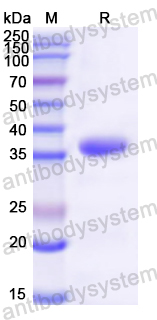Catalog No.
YMC27101
Expression system
E. coli
Species
Mus musculus (Mouse)
Protein length
Asn438-Tyr519
Predicted molecular weight
37.36 kDa
Nature
Recombinant
Endotoxin level
Please contact with the lab for this information.
Purity
>90% as determined by SDS-PAGE.
Accession
Q61207
Applications
ELISA, Immunogen, SDS-PAGE, WB, Bioactivity testing in progress
Form
Lyophilized
Storage buffer
Lyophilized from a solution in PBS pH 7.4, 0.02% NLS, 1mM EDTA, 4% Trehalose, 1% Mannitol.
Reconstitution
Reconstitute in sterile water for a stock solution. A copy of datasheet will be provided with the products, please refer to it for details.
Shipping
In general, proteins are provided as lyophilized powder/frozen liquid. They are shipped out with dry ice/blue ice unless customers require otherwise.
Stability and Storage
Use a manual defrost freezer and avoid repeated freeze thaw cycles. Store at 2 to 8°C for frequent use. Store at -20 to -80°C for twelve months from the date of receipt.
Alternative Names
Prosaposin, Sulfated glycoprotein 1, SGP-1, Saposin-A, Saposin-B-Val, Saposin-B, Saposin-C, Saposin-D, Psap, Sgp1
Acute mountain sickness prediction: a concerto of multidimensional phenotypic data and machine learning strategies in the framework of predictive, preventive, and personalized medicine., PMID:40438497
Target Screening and Single Cell Analysis of Diabetic Retinopathy and Hepatocarcinoma., PMID:40293350
AZP2006 (Ezeprogind®): a Promising New Drug Candidate in the Battle Against Neurodegenerative Diseases., PMID:40150858
Seminal plasma proteomics of asymptomatic COVID-19 patients reveals disruption of male reproductive function., PMID:40119256
HEXB Drives Raised Paucimannosylation in Colorectal Cancer and Stratifies Patient Risk., PMID:39947398
Understanding definitive and probable stroke-associated pneumonia: Risk factors and clinical outcomes., PMID:39923495
Oligodendrocytes drive neuroinflammation and neurodegeneration in Parkinson's disease via the prosaposin-GPR37-IL-6 axis., PMID:39913287
In-Depth Proteomic Analysis of Tissue Interstitial Fluid Reveals Biomarker Candidates Related to Varying Differentiation Statuses in Gastric Adenocarcinoma., PMID:39912886
Exploring the therapeutic potential of α-(Phenylselanyl) acetophenone in tumor necrosis Factor-α-Induced depressive-like and hyperalgesic behavior in mice., PMID:39884490
RNPS1 in PSAP complex controls periodic pre-mRNA splicing over the cell cycle., PMID:39687031
A novel homozygous PSAP mutation identified by whole exome sequencing in a consanguineous family with metachromatic leukodystrophy: a case report., PMID:39612318
Genetically modified E. Coli secreting melanin (E.melanin) activates the astrocytic PSAP-GPR37L1 pathway and mitigates the pathogenesis of Parkinson's disease., PMID:39523310
Machine Learning Analysis of RNA-Seq Data Identifies Key Gene Signatures and Pathways in Mpox Virus-Induced Gastrointestinal Complications Using Colon Organoid Models., PMID:39456924
Increased expression of the proapoptotic presenilin associated protein is involved in neuronal tangle formation in human brain., PMID:39455681
Dissecting the roles of prosaposin as an emerging therapeutic target for tumors and its underlying mechanisms., PMID:39405903
Machine learning model base on metabolomics and proteomics to predict cognitive impairment in Parkinson's disease., PMID:39394257
Network and systems biology approaches help investigate gene regulatory interactions between Salmonella disease and host in chickens: Model-based in silico evidence combined with gene expression assays., PMID:39392284
[Study on the correlation between glycolipids and prostate volume in patients with benign prostatic hyperplasia]., PMID:39290021
Activation of the muscle-to-brain axis ameliorates neurocognitive deficits in an Alzheimer's disease mouse model via enhancing neurotrophic and synaptic signaling., PMID:39269584
[Isolated intraductal carcinoma of the prostate: a clinicopathological and molecular analysis]., PMID:39103261
Prosaposin hyperglycosylation: a novel tumor immune escape mechanism and implications for cancer immunotherapy., PMID:38982080
Deficiency of Glucocerebrosidase Activity beyond Gaucher Disease: PSAP and LIMP-2 Dysfunctions., PMID:38928321
Loss of Inpp5d has disease-relevant and sex-specific effects on glial transcriptomes., PMID:38923164
Rare histologic transformation of a CTNNB1 (β-catenin) mutated prostate cancer with aggressive clinical course., PMID:38907236
Four-Dimensional Label-Free Quantitative Proteomics of Ginsenoside Rg2 Ameliorated Scopolamine-Induced Memory Impairment in Mice through the Lysosomal Pathway., PMID:38885433
Distribution of prostatic markers in glands of the female urethra and anterior vaginal wall-a rapid autopsy study., PMID:38808370
Balanced Solution Versus Normal Saline in Predicted Severe Acute Pancreatitis: A Stepped Wedge Cluster Randomized Trial., PMID:38708888
Selective prosaposin expression in Langerhans islets of the mouse pancreas., PMID:38537378
Prosaposin maintains adult neural stem cells in a state associated with deep quiescence., PMID:38518783
The exon junction complex is required for DMD gene splicing fidelity and myogenic differentiation., PMID:38512499
Prosaposin is a novel coenzyme Q10-binding protein., PMID:38510690
Pathogenesis of Parkinson's disease: from hints from monogenic familial PD to biomarkers., PMID:38478097
Proteomics analysis of differentially abundant proteins in the rohu kidney infected with Edwardsiella tarda., PMID:38430708
Hyperglycosylation of prosaposin in tumor dendritic cells drives immune escape., PMID:38207022
Meta-analysis of the association of prosaposin polymorphisms rs4747203 and rs885828 with risk of Parkinson's disease., PMID:38206457
The Arabidopsis SR45 splicing factor bridges the splicing machinery and the exon-exon junction complex., PMID:38180875
Intranasal administration of recombinant prosaposin attenuates neuronal apoptosis through GPR37/PI3K/Akt/ASK1 pathway in MCAO rats., PMID:38114054
Neurotoxic stimulation alters prosaposin levels in the salivary systems of rats., PMID:38082139
Cascading effects of hypobaric hypoxia on the testis: insights from a single-cell RNA sequencing analysis., PMID:38033870
Dysfunction of Drosophila mitochondrial carrier homolog (Mtch) alters apoptosis and disturbs development., PMID:38013241
Aberrant expression of GATA3 in metastatic adenocarcinoma of the prostate: an important pitfall., PMID:37965687
Prosaposin maintains lipid homeostasis in dopamine neurons and counteracts experimental parkinsonism in rodents., PMID:37726325
Correlation between E-cadherin/β-catenin, Vimentin expression, clinicopathologic features and drug resistance prediction in naïve prostate cancer: A molecular and clinical study., PMID:37649322
Colostrum Features of Active and Recovered COVID-19 Patients Revealed Using Next-Generation Proteomics Technique, SWATH-MS., PMID:37628421
Functional role of SAP18 protein: From transcriptional repression to splicing regulation., PMID:37486712
Efferocytes release extracellular vesicles to resolve inflammation and tissue injury via prosaposin-GPR37 signaling., PMID:37436891
Late infantile and adult-onset metachromatic leukodystrophy due to novel missense variants in the PSAP gene: Case report from India., PMID:37404680
Single-cell RNA-sequencing analysis reveals enhanced non-canonical neurotrophic factor signaling in the subacute phase of traumatic brain injury., PMID:37269057
Prosaposin PS18 reduces dopaminergic neurodegeneration in a 6-hydroxydopamine rat model of Parkinson's disease., PMID:37208379
A zebrafish model of combined saposin deficiency identifies acid sphingomyelinase as a potential therapeutic target., PMID:37183607


